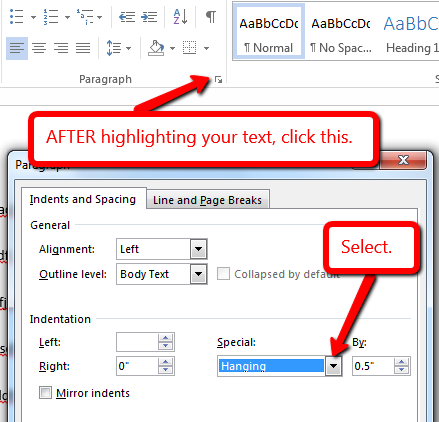



Perhaps I am missing something, but this seems an easy filter to implement that might make the switch to Mellel tab/indent format totally transparent to the user. To make the paragraph work in Mellel, it should have a start margin equal to the indent (0pt), the right (reverse) tab in the same place (10 pt) and a combo tab from 20pt to 48pt.Īfter a little experimentation, it seems to me the solution is as simple as identifying paragraphs being pasted in RTL with tabs left of the start margin and then moving the start margin to be equal to the indent and replacing the rightmost left (regular) tab with a combo tab between it and the location of the former start margin (which could, in theory, be in the same place). The standard depth is 0.5 inches (1.27cm).Would it be possible, when pasting RTL text, to convert paragraphs with tabs left of the hanging indent to use the Mellel "Combo Tab"? I am often copy-pasting text from the (English) Psalms from Logos Bible Software, only to find that the indentation gets all messed up because of the difference in how Mellel and Word (and most other word processors) handle tabs left of the hanging indent.įor example, I have paragraphs with an indent at 0pt, a start margin at 48pt, a right (reverse) tab at 10pt, and a left (regular) tab at 20pt. Open the “Special indent” drop-down menu and select “Hanging.” Adjust the depth of the indent as needed.Go down to “Align & indent” and select “Indentation options.” Click the “Format” option in the top menu.Instead of indenting each line manually using the “Enter” and “Tab” keys, use the special indentation feature in Google Docs.
Bookends mellel hanging indent how to#
You can create a hanging indent in Google Docs for some or all of your text. A tutorial demonstrating how to add temporary citations from Bookends into Word and Mellel, and then scan the documents to produce final citations, footnotes. Drag the “Left Indent” marker (the lower triangular marker) to where you want the second and subsequent lines of the selected paragraphs to start.įor a hanging indent of 0.5 inches (1.27 cm), position the upper triangular marker at the border and drag the lower triangular marker to the first mark after 1 cm.Using the ruler, drag the “First Line Indent” marker (the upper triangular marker) to where you want the first line of each paragraph of the selected text to start (the standard is 1 inch or 2.54cm).If the ruler is not displayed at the top of your document, click the “View” tab in the ribbon menu and tick the “Ruler” option box. This method uses the ruler in Word to create a hanging indent. The standard depth is 0.5 inches (1.27 cm). In the “Indentation” section, open the “Special” drop-down menu and select “Hanging.” Use the “By” feature to adjust the depth of the indent.Right-click the highlighted text and select “Paragraph.”.This ensures that the first line of each entry will begin at the left margin. If you have multiple citation entries, press the enter key once after each entry. This method uses the paragraph settings in Word to set a hanging indent. Instead of indenting each line manually using the “Enter” and “Tab” keys, use the indentation features in Word. You can create a hanging indent in Microsoft Word for some or all of your text. Frequently asked questions about hanging indentsĬreating a hanging indent in Microsoft Word.To indent the first line of a paragraph, see Indent the first line of a paragraph. To add a drop cap to your paragraph, see Insert a drop cap. You can adjust the depth of the indent using the By field. The standard depth is 0.5 inches (1.27 cm). Go to Home > Paragraph dialog launcher > Indents and Spacing. Use the By feature to adjust the depth of the indent. In the Indentation section, open the Special drop-down menu and select Hanging. Right-click the highlighted text and select Paragraph. Creating a hanging indent in Google Docs This ensures that the first line of each entry will begin at the left margin.Creating a hanging indent in Microsoft Word.


 0 kommentar(er)
0 kommentar(er)
